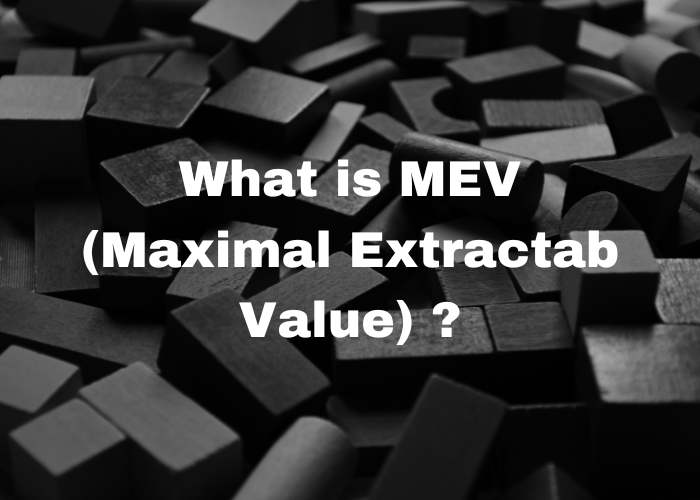Maximal extractable value (MEV) is the highest potential value that miners or network validators can extract by rearranging and reordering transactions in the queue before they are added to the blockchain.
Main Points
- MEV stands for the maximum value that miners or network validators can capture by changing the order of transactions that are pending confirmation.
- It is often known as the “invisible tax,” representing the profit that miners collect from other participants in the cryptocurrency market.
- MEV is especially prevalent on the Ethereum, Solana, BSC network but is not limited to this particular smart contract platform.
- This article delves into the concept of maximal extractable value, its impact on the crypto industry, and ways to avoid it.

The MEV phenomenon was first brought to attention in 2014 by a pseudonymous algorithmic trader known as Pmcgoohan. They predicted that miners could potentially manipulate transactions during the validation process to earn a profit. In a Reddit post, Pmcgoohan wrote, “Miners can see all the contract code they run (obviously), and the order in which transactions are processed is up to individual miners. What is to stop front running by a miner in any marketplace implementation by Ethereum?”
The term MEV, however, was not introduced until 2019 when Phil Daian and other smart contract researchers published a paper titled “Flash Boys 2.0.” In this paper, the term referred to miner extractable value, which Daian and his team defined as the total amount of ETH miners could extract by reordering transactions within a single block.
In 2022, after Ethereum shifted from the Proof-of-Work (PoW) to the Proof-of-Stake (PoS) consensus mechanism, the term MEV evolved to “maximal extractable value.” This change reflected a broader range of techniques for extracting value from users. Although the MEV phenomenon is most prominent on Ethereum, it is also prevalent on other blockchains.
How Does MEV Work?
Maximal extractable value (MEV) arises from the decentralized nature of blockchain technology and the cryptocurrency industry. Unlike traditional finance, where transaction orders are strictly enforced, crypto miners and validators have the flexibility to reorder and arrange transactions within a block as they see fit.
In decentralized cryptocurrency systems using both Proof-of-Work (PoW) and Proof-of-Stake (PoS) consensus mechanisms, pending transactions are temporarily held in the blockchain’s mempool, a publicly accessible waiting area. Miners or network validators select transactions from this mempool and arrange them to form a block, which is then verified and added to the blockchain. Ideally, miners and validators would prioritize transactions based on gas fees. However, due to the transparency of the mempool, they can explore other lucrative opportunities, such as arbitrage, sandwich attacks, and liquidations, to extract additional value.
While miners and validators are theoretically positioned to capture the maximal extractable value due to their role in executing and validating transactions, in practice, most MEV extraction is conducted by independent participants known as “searchers.” These searchers use sophisticated algorithms and bots to identify MEV opportunities and profit from them.
In common MEV scenarios, searchers pay high gas fees to motivate miners or validators to include their transactions in specific blocks, allowing them to capture extra value. These gas fees act as incentives and represent a portion of the maximal extractable value that miners and validators receive. Recently, there have even been instances where searchers collaborate directly with miners or validators to facilitate MEV extraction.
Exploring MEV Types
To grasp the concept of MEV thoroughly, it’s important to explore the various methods searchers use to create additional value in the market. In the following sections, we will delve into the details of the different types of MEV present in today’s crypto world.
- DEX Arbitrage
In traditional finance, arbitrage involves exploiting price differences for the same asset across various trading platforms. Similarly, in MEV extraction, arbitrage takes advantage of token price discrepancies across multiple decentralized exchanges (DEXs).
With this type of MEV, searchers create additional value by buying tokens at a lower price on one exchange and selling them on another exchange where the price is higher. They can also profit by exploiting price differences across different liquidity pools within the same exchange.
For instance, consider two separate liquidity pools (LP1 and LP2) for BUSD/SOL on PancakeSwap V2, with exchange rates of 143 BUSD and 146 BUSD for 1 SOL, respectively. - Liquidations
In decentralized finance, liquidation happens when a borrower’s collateral no longer covers the value of their loan or debt. When a debt is liquidated, anyone can buy the original collateral at a discounted price and then sell it at a higher price to earn a profit.
In this form of MEV, searchers function as liquidators who monitor the blockchain for undercollateralized loan positions that require liquidation. These searchers locate loans eligible for liquidation, purchase the borrowers’ collateral at a discount, and resell it at a higher price to generate additional value.
Generally, this type of MEV is considered neutral and not harmful, as liquidations are a common feature in any financial system that involves lending and borrowing. However, there are instances where liquidations can be exploitative, known as “toxic liquidations.” - Sandwich Attacks
Sandwich attacks are a harmful form of MEV, where the searcher strategically places a transaction before a targeted trade (front-running) and another transaction immediately after it (back-running). This tactic is commonly used to exploit large orders that lead to significant price movements of an asset.
Here’s a straightforward explanation of a sandwich attack:
– The MEV searcher places a buy order first, pushing the asset’s price higher.
– The targeted MEV trader then buys the asset at the inflated price.
– Finally, the MEV searcher sells the asset at this higher price, profiting from the difference caused by the price change. - In front-running
In front-running is the initial step in a sandwich attack, where searchers scan a blockchain’s mempool for pending transactions that might influence the price of a specific asset and present an opportunity to extract significant value. For example, if a frontrunner—often a sophisticated bot—identifies a large buy order for a particular cryptocurrency, it anticipates that the transaction will drive up the token’s price once confirmed.
To capitalize on this, the bot places a buy order for the same token, aiming to have its transaction processed before the detected large order. By assigning a higher gas price to their transaction, the bot incentivizes validators to prioritize its buy order over the initial transaction, ensuring it is executed first. - Back-running
To finalize the sandwich attack, the bot places a sell order designed to be executed immediately after the target transaction, allowing it to sell the asset at the elevated price. This tactic is called back-running, achieved by setting a lower gas price for the sell order to ensure it is validated after the target transaction.
As a result, this form of MEV reduces the value that the targeted traders would have gained from their original transactions. Meanwhile, the searcher profits from the price changes caused by the target transaction.
MEV Attacks Explained and How to Safeguard Against Them
After exploring the different types of MEV, it becomes evident how MEV attacks can have a substantial impact on participants within a blockchain network, especially in the decentralized finance sector. Here are some strategies to help you avoid becoming a victim of MEV attacks.
RPC Endpoints (MEV Blockers)
MEV blockers are software tools designed to protect users from MEV exploitation. Since MEV extraction involves rearranging transactions into a more profitable sequence, users can avoid this manipulation by submitting their transactions to a specialized network of searchers who follow rules that ensure favorable outcomes for users.
MEV blockers function via RPC (Remote Procedure Call) endpoints, which act as a communication protocol between the blockchain and a user’s wallet. These RPC endpoints securely redirect transactions to the specialized network of searchers instead of the publicly accessible mempool, where malicious searchers may exploit them.
The searchers within this network are committed to not front-running or sandwiching users’ transactions. Instead, they work to extract value in ways that benefit users, such as back-running large transactions and returning a significant portion of the gains to the users.
Using Lower Slippage Tolerance
Slippage refers to the difference between the expected execution price of a transaction and the actual price at which it is executed. This often occurs in cryptocurrency markets due to their inherent volatility and is one of the factors that enable certain MEV attacks.
Slippage tolerance is a setting that allows a transaction to be executed only if the token price stays within a specified range. By setting a lower slippage tolerance, users can protect themselves against sandwich attacks and minimize unexpected losses.
For example, an exploiter might place a large order before a trader’s transaction, causing a substantial shift in the token’s price. If this price change exceeds the trader’s slippage tolerance, the transaction will be canceled.
Priority Gas Network Fees
While choosing lower gas fees for transactions may be the most cost-effective approach, it also comes with the risk of slower processing times, making the transactions vulnerable to malicious actors. Therefore, traders should consider paying priority gas fees, especially for large transactions, to reduce the risk of falling prey to MEV attacks.
Transactions with higher gas fees are prioritized by miners or validators, making it more costly for attackers to front-run them, as they would need to pay even higher fees. This increased cost and reduced reward ratio can deter most searchers from targeting such transactions.
Native MEV Safeguards in DEXs
Traders can safeguard themselves from MEV exploits by using DEXs or dApps specifically designed to reduce the impact of MEV. For example, CoW Protocol is a DEX aggregator that uses batch auctions and intents as its trading mechanism to achieve favorable outcomes for users.
A batch auction groups multiple orders together and “auctions” them to execution parties, known as solvers, who compete to find the most optimal settlement paths. This method enforces certain execution rules that help prevent MEV exploits.
Summary and Insights
Maximal extractable value (MEV) is a phenomenon in the crypto space that has continually evolved over the years. To effectively navigate the changing landscape and mitigate the risks associated with MEV, it’s crucial to understand the different techniques employed on various blockchain platforms to prevent falling victim to these exploits.
As discussed in this article, there are both individual strategies and protocol-level methods available for protecting against MEV-related activities. While some forms of MEV extraction are considered harmful, there are also benefits to having these activities within the cryptocurrency market.
For example, MEV strategies like arbitrage contribute to market efficiency by aligning prices across multiple exchanges. Overall, maximal extractable value is a complex and evolving topic that warrants deeper exploration for a thorough understanding.







